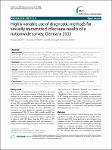Highly variable use of diagnostic methods for sexually transmitted infections-results of a nationwide survey, Germany 2005
Gilsdorf, Andreas
Hofmann, Alexandra
Hamouda, Osamah
Bremer, Viviane
Background: Sexual transmitted infections (STIs) have increased in Germany and other countries in Europe since the mid-nineties. To obtain a better picture of diagnostic methods used in STI testing institutions in Germany, we performed a nationwide survey amongst STI specialists in order to evaluate the quality of STI reports and provide recommendations to harmonize and possibly improve STI diagnostics in Germany. Methods: We asked sentinel physicians and randomly chosen gynaecologists, urologists and dermato-venerologists, about the diagnostic methods used in 2005 to diagnose HIV, chlamydia (CT), gonorrhoea (GO) and syphilis (SY) in a national cross-sectional survey in order to recognize potential problems and provide recommendations. Results: A total of 739/2287 (32%) physicians participated. Of all participants, 80% offered tests for HIV, 84% for CT, 83% for GO and 83% for SY. Of all participants who performed HIV testing, 90% requested an antibody test, 3% a rapid test and 1% a nucleic acid amplification test (NAAT). For CT testing, NAAT was used in 33% and rapid tests in 34% of participants. GO resistance testing was performed by 31% of the participants. SY testing was performed in 98% by serology. Conclusions: Diagnostic methods for STI vary highly among the participants. Diagnostic guidelines should be reviewed and harmonised to ensure consistent use of the optimal STI diagnostic methods.
Dateien zu dieser Publikation
Keine Lizenzangabe

